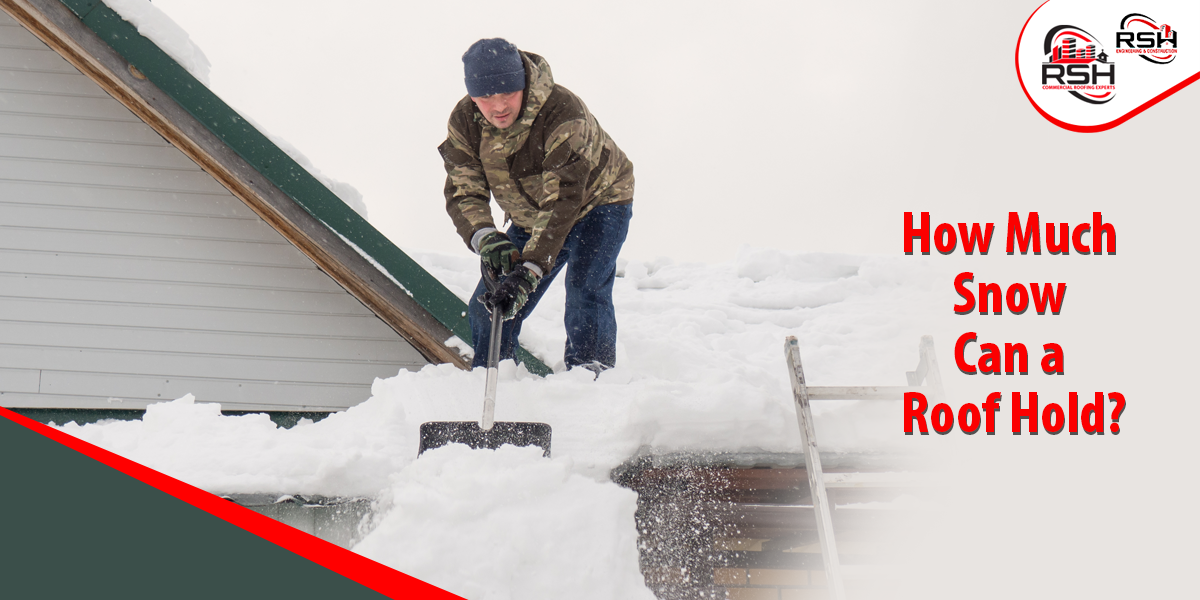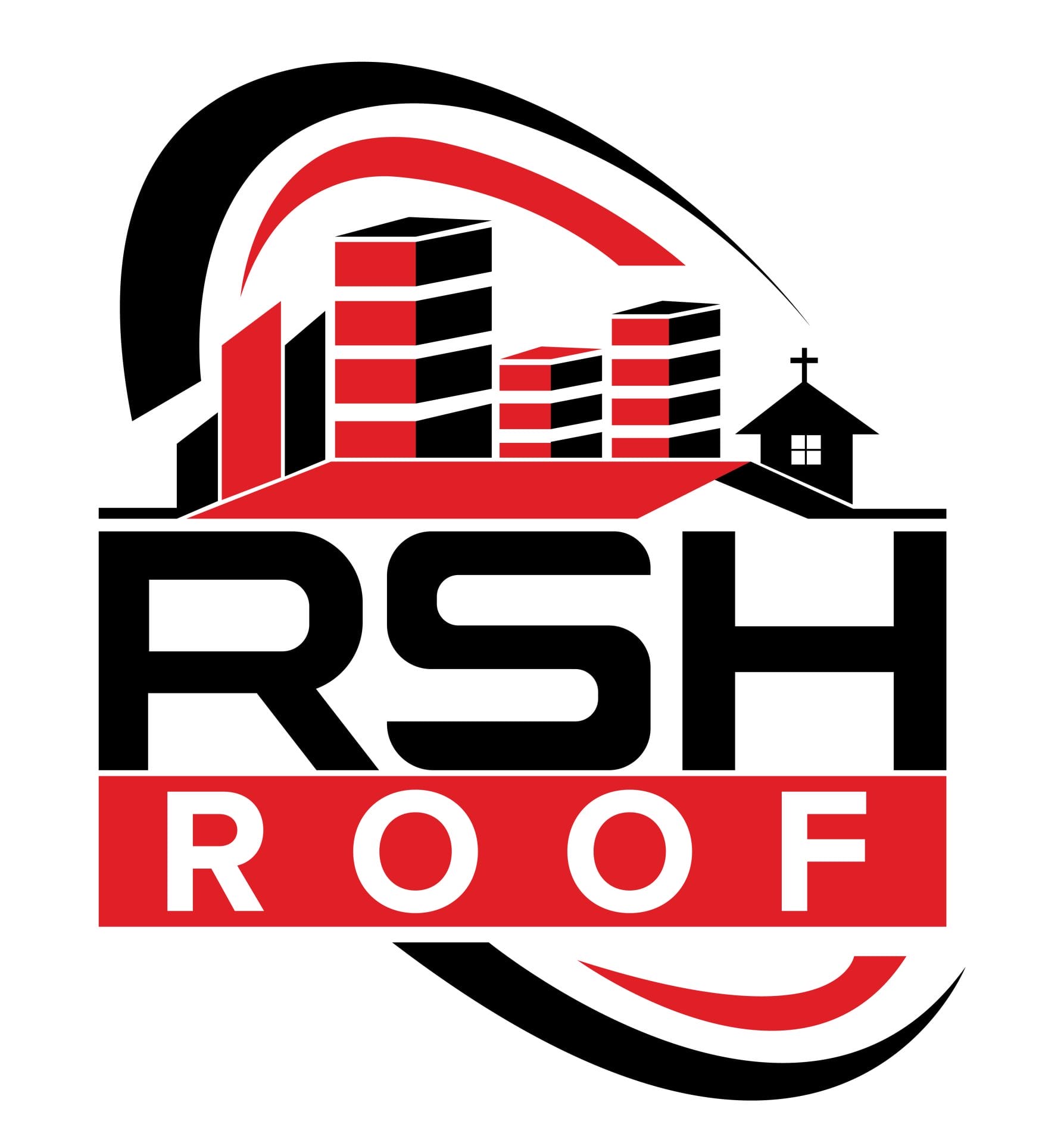RSH Commercial Roofing is a Professional Engineering & Construction Company with 25+ years of experience that specializes in Commercial & Residential Roof Inspections, Repair/Replacement services as well as commercial roofing insurance claims.

How Much Snow Can a Roof Hold?
Introduction
As winter arrives, the allure of snow-covered roofs is undeniable, transforming landscapes into winter wonderlands. However, beneath this picturesque scene lies the potential danger of snow accumulation on roofs. In this comprehensive guide, we’ll delve into the intricacies of snow load on roofs, exploring the basics and the critical factors influencing roof snow load capacity, how much snow can a roof hold, and the specific considerations for commercial roofs. Let’s unravel the nuances of snow load to ensure the safety and longevity of your roofing structure.
What is the Snow Load on Roof?
The concept of snow load on a roof is straightforward – it refers to the weight of accumulated snow on the roof’s surface. The weight is measured in pounds per square foot (PSF) or kilograms per square meter (kg/m²), providing a tangible metric for the potential stress on the structure. It’s a dynamic value influenced by various factors, making it essential for property owners to comprehend the nuances of effectively assessing and managing snow load.
Determining Roof Snow Load Capacity
Understanding a roof’s snow load capacity is paramount for maintaining structural integrity. This capacity is not a one-size-fits-all metric; it is influenced by factors such as the roof’s design, materials used, and geographic location. The ability of a roof to withstand the weight of accumulated snow without risking damage or collapse is a critical aspect of structural engineering. Roof snow load capacity is the maximum load a roof can handle, making it imperative to consider these factors during the construction and maintenance phases.
Factors Affecting Snow Load
The complexities of snow load extend beyond its mere weight. Snow density, influenced by temperature and moisture content factors, plays a crucial role. Several factors can influence the snow load on roof:
- Snow Density: Light, fluffy snow accumulates differently than wet, heavy snow. The latter can pose a higher risk due to its increased weight.
- Temperature: Warmer temperatures can lead to snow melting and refreezing, creating an ice layer that adds extra weight.
- Roof Pitch: The pitch or slope of a roof affects how snow accumulates. Steeper roofs may shed snow more effectively, reducing the overall load.
How Much Snow Can a Roof Hold?
Determining the maximum snow load a roof can safely bear requires a nuanced approach. Building codes, specific to geographical regions, provide guidelines on acceptable snow load limits for roofs. These guidelines consider local climate patterns and historical data to establish safe parameters. Utilizing snow load calculators, which factor in variables like roof pitch and anticipated snow density, aids in precise assessments, offering property owners valuable insights into their roof’s capacity.
Measuring Snow Load
Accurate measurement of snow load is essential for proactive roof management. Snow load calculators, available online, consider various parameters to provide a reliable estimate. These tools consider geographical location, roof pitch, and anticipated snow density. Regularly monitoring snow load levels during winter months allows property owners to stay ahead of potential issues, enabling timely intervention and minimizing the risk of structural damage.
Commercial Roof Considerations
Commercial roofs present unique challenges due to their often expansive and flat design. Unlike sloped roofs, where snow may naturally slide off, flat roofs require specialized attention from flat roof specialists. These professionals understand the challenges of flat roofs, where snow can accumulate differently. Investing in the expertise of specialists ensures that commercial roofs are adequately prepared to handle winter conditions.
Addressing Snow Load Issues
In snow load management, proactive roof maintenance emerges as the linchpin to avert potential structural challenges. When concerns arise over the accumulation of excessive snow on roof, seeking the expertise of a professional roof contractor is not just advisable; it is a strategic move toward safeguarding your property. These professionals bring knowledge and experience, equipped to conduct meticulous inspections beyond a surface-level assessment.
Thorough Inspections:
Professional roof contractors embark on a comprehensive examination of the roof structure. This involves scrutinizing various components, including the integrity of the roofing materials, the soundness of load-bearing elements, and the overall condition of supporting structures. The goal is to identify any existing vulnerabilities that may compromise the roof’s ability to bear additional snow load on roof.
Identifying Potential Weaknesses:
Through their keen eye and technical expertise, roof contractors can pinpoint weaknesses that might not be apparent to the untrained eye. This could range from weakened trusses or rafters to signs of structural fatigue, all of which are critical factors contributing to a roof’s overall load-bearing capacity.
Recommendations for Reinforcements or Adjustments:
Armed with a thorough understanding of the roof’s condition, professional roof contractors provide tailored recommendations for reinforcements or adjustments. These may include structural enhancements, additional support installations, or alterations to the roof’s design to distribute the load better. The aim is to fortify the roof against the anticipated snow load, ensuring it remains within safe parameters.
Protection Against Compounding Issues:
Timely intervention is not solely about addressing the immediate threat of excessive snow load; it’s also a proactive measure to prevent the compounding of existing issues. For instance, if a roof has pre-existing problems like a leaky roof, the added stress of snow accumulation can exacerbate these issues. By addressing snow load concerns and pre-existing problems concurrently, professional roof contractors offer a comprehensive solution that mitigates risks and preserves the roofing system’s longevity.
Holistic Approach to Roof Health:
Engaging a roofing contractor for snow load management goes beyond a reactive response to winter weather challenges. It embodies a holistic approach to roof health, considering not only the immediate concerns but also the long-term resilience of the structure. This commitment to comprehensive care ensures that the roof remains robust in the face of diverse challenges, from snow accumulation to the wear and tear of everyday weathering.
Conclusion
While the sight of snow-covered roofs evokes a sense of charm, it’s vital to recognize the potential risks associated with snow load on roof. Understanding the dynamics of snow load, being aware of your roof’s capacity, and taking proactive measures are paramount for ensuring the safety and longevity of your roofing structure. As winter approaches, don’t delay – prioritize the well-being of your roof to enjoy a worry-free season.
For expert guidance on managing snow load on your roof, trust the professionals at RSH Roof. As seasoned commercial roof repair specialists, we excel in addressing the unique challenges of flat roofs. Visit our website to explore a range of services tailored to your roofing needs. Our experts are ready to provide valuable insights, ensuring your roof is prepared to handle the winter challenges. Remember, a well-maintained roof is a secure roof.

